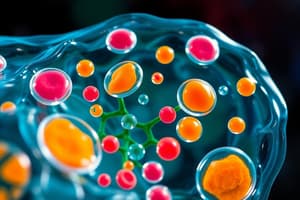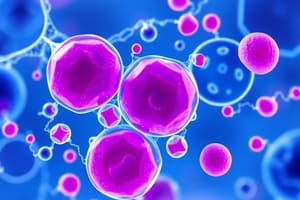Podcast
Questions and Answers
What is the function of mitochondria in a cell?
What is the function of mitochondria in a cell?
- Protein synthesis
- Calcium storage
- Digestion of biological molecules
- Conversion of cellular energy into ATP (correct)
Which organelle is involved in modifying, sorting, and packaging proteins and lipids into vesicles for delivery within the cell or to other cells?
Which organelle is involved in modifying, sorting, and packaging proteins and lipids into vesicles for delivery within the cell or to other cells?
- Ribosomes
- Endoplasmic reticulum (ER)
- Golgi apparatus (correct)
- Lysosomes
Which organelle is responsible for containing the cell's genetic material, DNA, and regulating genetic expression?
Which organelle is responsible for containing the cell's genetic material, DNA, and regulating genetic expression?
- Ribosomes
- Endoplasmic reticulum (ER)
- Nucleus (correct)
- Lysosomes
Where can ribosomes be found in a cell?
Where can ribosomes be found in a cell?
Which organelle serves as membrane-bound sacs containing digestive enzymes for breaking down biological molecules?
Which organelle serves as membrane-bound sacs containing digestive enzymes for breaking down biological molecules?
What is the function of a centrosome in a cell?
What is the function of a centrosome in a cell?
Which organelle is responsible for photosynthesis and energy production?
Which organelle is responsible for photosynthesis and energy production?
What is the main function of peroxisomes in a cell?
What is the main function of peroxisomes in a cell?
Which structure is a rigid, protective layer found in plant and fungal cells?
Which structure is a rigid, protective layer found in plant and fungal cells?
What is the function of the cell membrane in a cell?
What is the function of the cell membrane in a cell?
Study Notes
Exploring Cell Biology's Building Blocks: Cell Organelles and Structure
Cell biology is a field that delves into the inner workings and functions of individual cells, their interactions, and the formation of multicellular systems. The structure of a cell is primarily defined by its organelles, specialized subunits that carry out specific tasks essential for life.
Cell Organelles
Cells contain various organelles, each with its unique function. Some key organelles include:
-
Nucleus: Contains the cell's genetic material, DNA, and is responsible for genetic expression and regulation.
-
Endoplasmic reticulum (ER): A network of membranous tubules and flattened sacs involved in protein synthesis, lipid synthesis, and calcium storage.
-
Ribosomes: Cellular machines that synthesize proteins using mRNA as a template. Ribosomes can be found both in the cytoplasm and attached to the ER (ribosomes on ER, or RER).
-
Lysosomes: Membrane-bound sacs containing digestive enzymes that break down biological molecules.
-
Mitochondria: Known as the powerhouses of the cell, mitochondria convert cellular energy stored in nutrients into a form that the cell can use, producing ATP.
-
Golgi apparatus: A series of membranous sacs and tubules that modify, sort, and package proteins and lipids into vesicles for delivery to their proper destinations within the cell or to other cells.
-
Centrosome: A microtubule-organizing center that plays a crucial role in cell division and maintaining the cell's shape.
-
Peroxisomes: Organelles involved in various metabolic processes, including detoxification and the breakdown of toxic compounds.
-
Chloroplasts: Only present in plant cells, these organelles are responsible for photosynthesis and energy production.
Cell Structure
Cells are also defined by their overall structure:
-
Cytoplasm: The fluid inside a cell, containing organelles and dissolved molecules such as enzymes, salts, and sugars.
-
Cell membrane: The lipid bilayer that separates the cell's interior from its external environment. The cell membrane is selectively permeable, allowing the passage of some molecules while restricting others.
-
Cell wall: A rigid, protective structure found in plant and fungal cells, composed of cellulose and other polysaccharides.
Understanding cell organelles and structure is crucial for comprehending the function of individual cells and the processes that govern the life of multicellular organisms. These components enable cells to carry out diverse functions, ultimately contributing to the development and progression of human diseases and the advancement of medicine. https://www.bumc.bu.edu/biochemcellbio/research/cellbiology/ https://learn.org/articles/Cell_Biology_Careers_Answers_to_Your_Questions.html
Studying That Suits You
Use AI to generate personalized quizzes and flashcards to suit your learning preferences.
Description
Test your knowledge on cell biology's building blocks, including cell organelles like nucleus, mitochondria, and lysosomes, as well as cell structures like cytoplasm and cell membrane. Learn about the functions and importance of these components in the intricate world of individual cells and their interactions.




